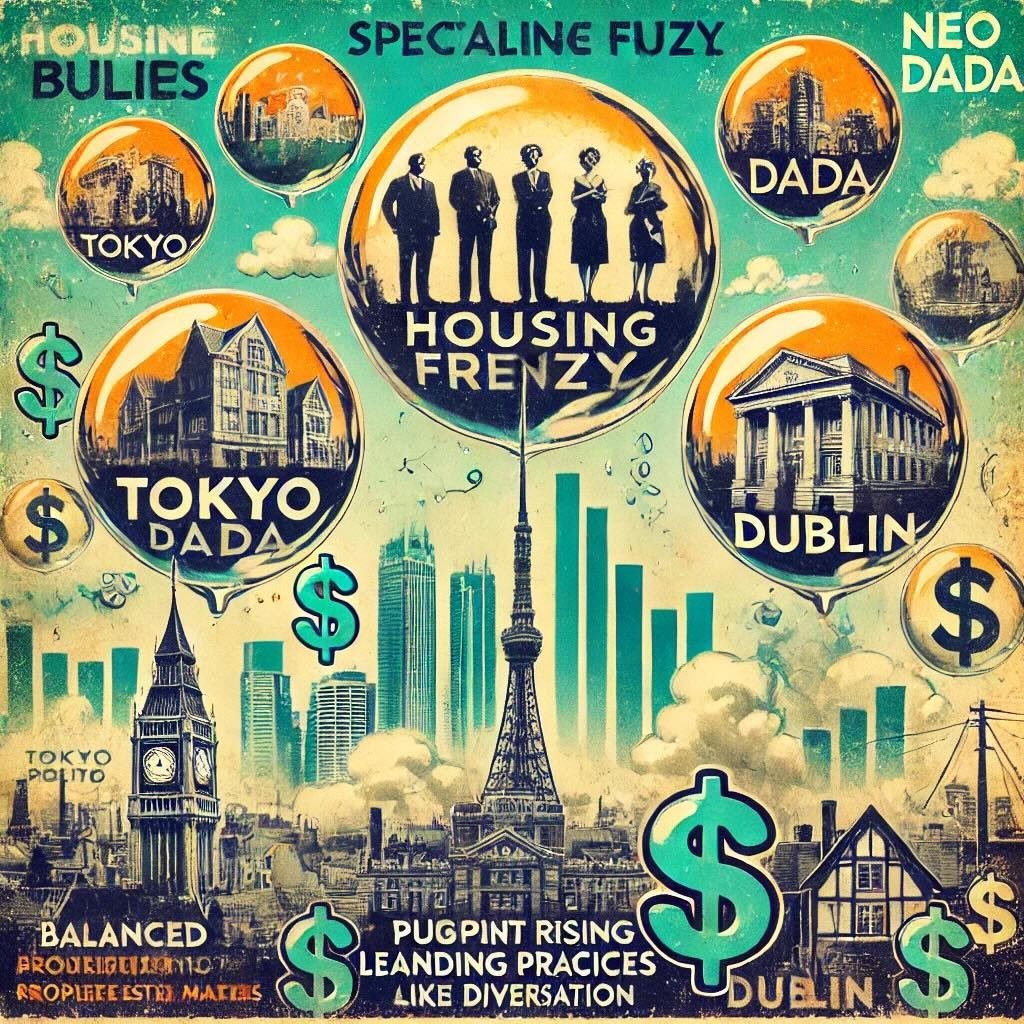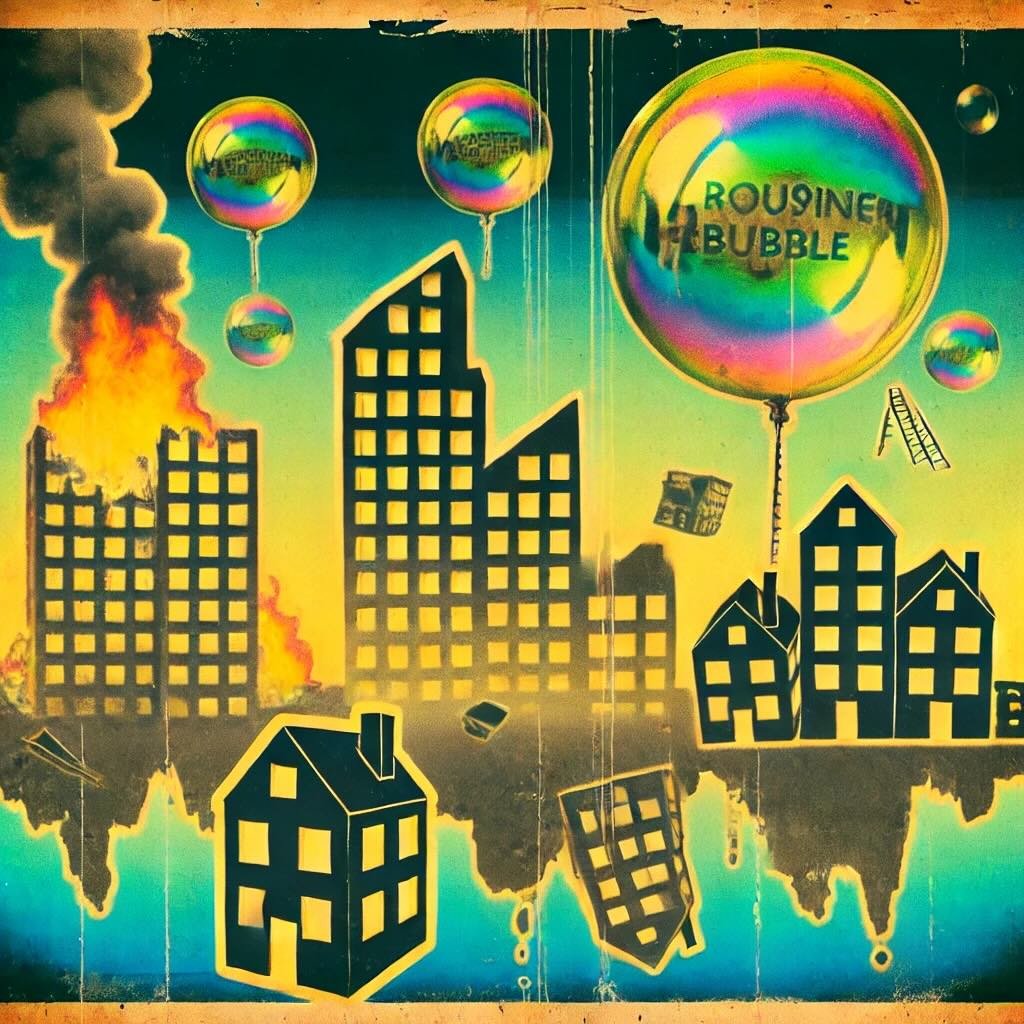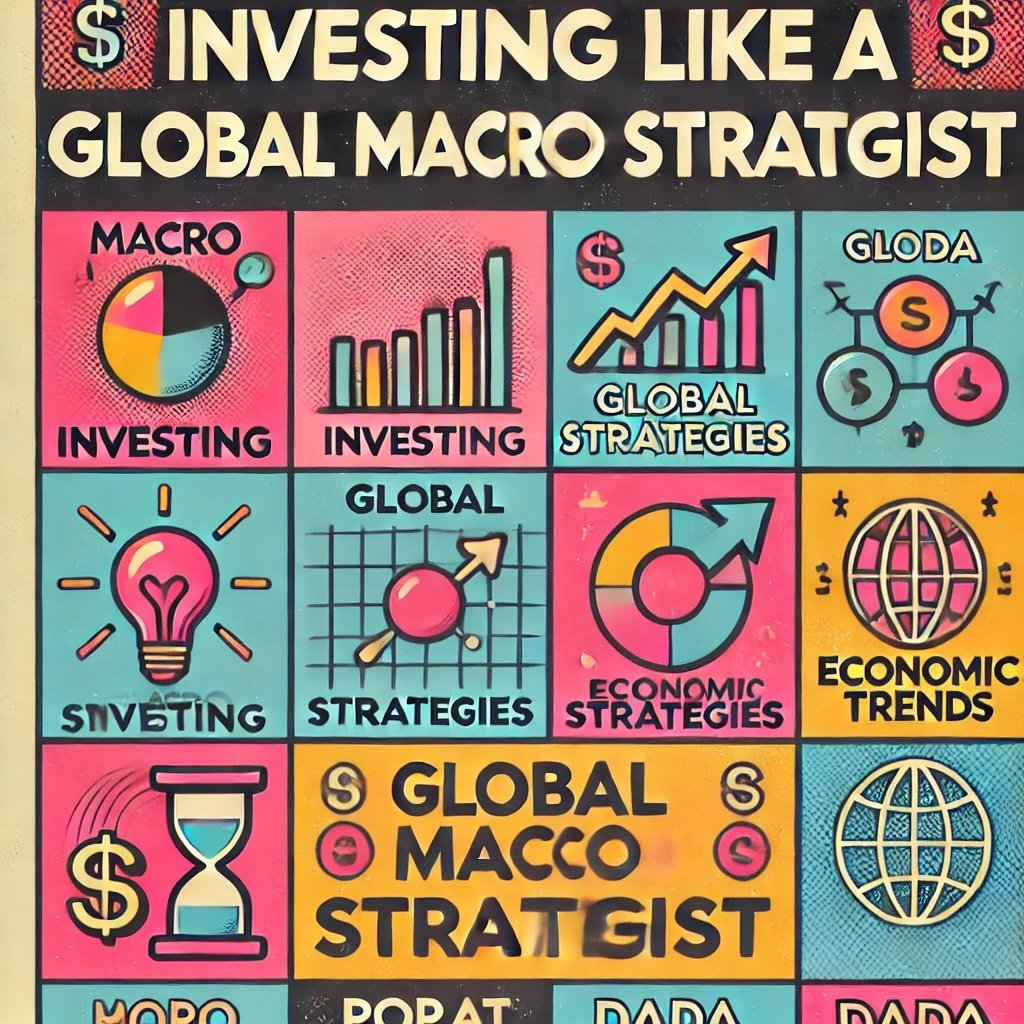A housing bubble—just the phrase can send shivers down the spine of anyone who lived through one. But what exactly is it? In simple terms, a housing bubble occurs when the price of homes skyrockets beyond what the fundamentals can justify. These inflated prices are often driven by factors like speculative buying, easy credit, and a herd mentality among investors. Everyone’s buying because, well, everyone else is. The trouble is, like all bubbles, housing bubbles eventually burst. When they do, the fallout can be catastrophic, leading to plummeting property values, foreclosures, and economic recessions.
source: TLDR News Global
Overview Of International Housing Bubble
The goal of this article is to dive deep into two of the most infamous housing bubbles in history: Tokyo in the 1980s and Dublin in the early 2000s. By examining these cases, we aim to uncover the key lessons they offer and how those lessons can be applied to today’s global real estate markets. What went wrong? Could it have been prevented? And most importantly, what can we learn to avoid making the same mistakes again?

Relevance to Current Markets
Why should we care about what happened decades ago in Japan or Ireland? Because history has a funny way of repeating itself. The conditions that led to the bubbles in Tokyo and Dublin—overvaluation, speculative frenzy, loose lending practices—are not confined to any one time or place. They can happen anywhere, and indeed, some experts argue that we’re seeing similar warning signs in certain markets today. By understanding these past bubbles, we can better navigate the complexities of the current housing market and, hopefully, avoid the painful consequences of another bubble burst.

The Tokyo Housing Bubble
Background and Context
Economic Boom of the 1980s
Japan in the 1980s was riding a wave of extraordinary economic growth. Fueled by rapid industrialization and urbanization, the country became a global economic powerhouse. Manufacturing, technology, and exports were booming, and Japan was on top of the world. Cities like Tokyo became magnets for both businesses and workers, driving up demand for land and housing. The economy seemed unstoppable.
However, this relentless growth also planted the seeds of what would become one of the largest housing bubbles in history. Loose monetary policies and overconfidence in the future led to an unchecked rise in asset prices, particularly in real estate and the stock market. Everyone—from investors to everyday citizens—wanted a piece of the action, and as demand soared, so did prices.
Real Estate and Stock Market Boom
The booming stock market was a major player in Tokyo’s real estate frenzy. As stock prices surged, companies and individuals found themselves flush with capital, which they eagerly funneled into real estate. The idea that land was a “safe” investment became ingrained in the culture. At one point, it was said that the land in central Tokyo was worth more than all of California!
Behind this boom was Japan’s loose monetary policy. The Bank of Japan kept interest rates low, making borrowing cheap and easy. This influx of credit further fueled speculation and real estate investment, pushing prices higher and higher.
Cultural Factors
In Japan, real estate wasn’t just about property ownership—it was deeply tied to social status and future security. Owning land, particularly in a place like Tokyo, became a symbol of wealth and success. This cultural attitude only intensified the bubble, as people saw property not just as an investment but as a necessary part of their social standing.
There was also a sense that land was limited, especially in urban areas, and its value would only go up. The belief that “land never loses value” became deeply rooted in the collective mindset, further driving demand and speculation.
Key Characteristics of the Tokyo Bubble
Rapid Price Increases
The rise in property prices in Tokyo during the late 1980s was nothing short of staggering. Land prices in Tokyo’s prime districts more than tripled between 1985 and 1990. By the late 1980s, the cost of land had reached levels that were completely disconnected from reality. The bubble was inflating at an unsustainable rate, with everyone rushing to buy before prices went up even further.
Speculation and Overvaluation
Much of this price growth wasn’t driven by real demand but by speculation. Investors were buying properties not to live in or use, but to flip for a profit. Land was traded like stocks, and prices were set by how much the next buyer was willing to pay, rather than any intrinsic value. This speculative mania created a feedback loop, pushing prices higher and higher as buyers expected endless gains.
In reality, property values became wildly overestimated. What was driving the market wasn’t economic fundamentals but a belief that prices could only go up, leading to a dangerous overvaluation.
Bank Lending Practices
Banks played a crucial role in the Tokyo bubble by engaging in aggressive lending. With interest rates so low, Japanese banks were more than happy to extend credit to property buyers and developers. Lenders often turned a blind eye to the risks involved, believing that the rising value of land would act as sufficient collateral.
In some cases, companies and individuals borrowed excessive amounts of money based on inflated property values, assuming they could sell at a higher price and pay off their debts. This free-flowing credit and lax lending standards only fueled the fire, pushing property prices to new, unsustainable heights.
The Burst of the Bubble
Economic Downturn
By the early 1990s, the Tokyo housing bubble had reached its breaking point. As the Bank of Japan began to tighten monetary policy and raise interest rates to curb inflation, the flow of cheap credit dried up. Suddenly, buyers were no longer able to afford the skyrocketing property prices, and the bubble burst. Property values, once thought invincible, began to plummet.
Investors who had purchased land at inflated prices were left with assets that were now worth far less than their loans. The impact wasn’t limited to the real estate sector—Japan’s entire economy felt the effects.
Impact on the Economy
The collapse of the Tokyo housing bubble led to what is now known as Japan’s “Lost Decade.” Throughout the 1990s and into the early 2000s, Japan suffered from stagnant growth, deflation, and a banking crisis. Companies cut back on investment, and consumer spending plummeted. The overextension of credit during the boom left the country saddled with debt, and the economy took years to recover.
For many, the dream of owning property in Tokyo turned into a financial nightmare. Foreclosures, bankruptcies, and the devaluation of assets became widespread. The economic downturn wasn’t just a financial crisis—it left deep scars on the Japanese psyche.
Government Response
In response to the bursting bubble, the Japanese government and the Bank of Japan implemented a series of measures. These included lowering interest rates, injecting liquidity into the banking system, and implementing various stimulus packages. However, these efforts were often seen as too little, too late.
One key lesson from Tokyo’s housing bubble is the importance of timely intervention. Had policymakers acted sooner to tighten lending standards or address the overheating market, the fallout might have been less severe. The Tokyo bubble serves as a stark reminder of the dangers of unchecked speculation, easy credit, and delayed government action.

The Dublin Housing Bubble
Background and Context
Celtic Tiger Economy
In the 1990s and early 2000s, Ireland was on a roll. The country experienced a period of rapid economic growth known as the Celtic Tiger, driven by a surge in foreign investment, particularly from tech companies. Ireland’s low corporate tax rates and access to the European market made it an attractive destination for multinational corporations, leading to a booming economy. Jobs were plentiful, wages were rising, and optimism was in the air. The Irish economy was transforming, and with it came a rising demand for housing.
Housing Boom
This economic boom naturally spilled over into the housing market. As the economy grew, so did the population’s desire for homeownership. Dublin, the capital and economic hub, saw an unprecedented surge in housing demand. People were eager to buy, and the supply of homes couldn’t keep up. Prices in Dublin and other parts of Ireland began to soar, driven by both genuine demand and the growing belief that property was a surefire investment.
But the rapid price increases weren’t just about demand—they were also about speculation. Investors, both domestic and foreign, poured money into Irish real estate, betting that prices would keep climbing. The more prices rose, the more people wanted in on the action, creating a feedback loop that sent property values through the roof.
Global Financial Context
The Dublin housing bubble didn’t exist in a vacuum. The global economic environment of the time played a significant role, particularly the low-interest rates and easy credit that were prevalent worldwide. Central banks, including the European Central Bank, kept interest rates low to encourage borrowing and spending. This made mortgages more accessible, allowing more people to buy homes and fueling the housing boom even further.
Additionally, the global financial markets were awash with liquidity, much of which found its way into real estate markets like Dublin. Banks were eager to lend, and borrowers were eager to take on debt, confident that property prices would continue to rise. This global context set the stage for the eventual collapse, as the interconnectedness of the financial markets meant that when one market faltered, the effects were felt far and wide.
Key Characteristics of the Dublin Bubble
Overbuilding and Speculation
As the housing market heated up, Ireland saw a frenzy of construction. Developers, eager to capitalize on the rising prices, built homes at a breakneck pace. New housing developments sprang up across Dublin and beyond, often without regard to actual demand. In many cases, these new homes were bought not by people looking for a place to live but by speculators hoping to flip them for a profit.
This overbuilding created a dangerous situation. As long as prices kept rising, everything seemed fine, but the market was becoming increasingly fragile. The supply of new homes eventually outpaced demand, especially as speculative buying pushed prices to unsustainable levels. When the market began to cool, this oversupply became a significant problem, leading to a sharp drop in property values.
Banking Sector Practices
The role of the banking sector in Dublin’s housing bubble cannot be overstated. Irish banks, flush with cash from foreign investors and low-interest rates, engaged in risky lending practices. They offered loans with minimal down payments and often required little to no documentation of income. The belief was that property values would continue to rise, so even if borrowers defaulted, the banks could recover their losses by selling the property.
But this reckless lending created a ticking time bomb. As more and more people took on debt they couldn’t afford, the market became increasingly unstable. When property values started to fall, many borrowers found themselves underwater—owing more on their mortgages than their homes were worth. The banking sector, which had fueled the boom with easy credit, suddenly found itself facing massive losses as defaults and foreclosures skyrocketed.
Government Policies
Government policies also played a role in inflating the Dublin housing bubble. In an effort to promote homeownership and economic growth, the Irish government introduced various incentives for property development and home buying. Tax breaks for property investors, grants for first-time homebuyers, and other measures all contributed to the boom.
While these policies were well-intentioned, they had unintended consequences. By making it easier for people to buy homes, the government inadvertently contributed to the speculative frenzy that drove prices up. In hindsight, it’s clear that these incentives, combined with lax regulation of the banking sector, created a perfect storm for a housing bubble.
The Burst of the Bubble
Global Financial Crisis
The Dublin housing bubble came crashing down in 2008, triggered by the global financial crisis. As the crisis spread, the flow of credit dried up, and the Irish property market, already stretched to its limits, collapsed. Home prices plummeted, leaving many borrowers with mortgages far exceeding the value of their homes. The once-booming housing market turned into a nightmare almost overnight.
The crisis exposed the weaknesses in the Irish banking system, which had been heavily reliant on the housing market. As defaults mounted, the banks found themselves on the brink of collapse, leading to a full-blown banking crisis. The ripple effects were felt throughout the economy, leading to widespread job losses and a sharp economic downturn.
Economic and Social Impact
The bursting of the Dublin housing bubble had devastating economic and social consequences. Mass unemployment swept through Ireland as the construction industry ground to a halt, and other sectors were hit by the recession. Many people who had bought homes at the peak of the market found themselves in negative equity, unable to sell their homes or refinance their mortgages.
The crisis also sparked a wave of emigration as people left Ireland in search of better opportunities abroad. Entire communities were affected as homes were abandoned, and neighborhoods fell into decline. The social fabric of the country was deeply shaken, and the recovery process would take years.
Recovery Efforts
In the aftermath of the bubble, the Irish government implemented a series of recovery efforts. These included austerity measures, bank bailouts, and eventually, a significant restructuring of the banking sector. The government also sought assistance from international organizations, including the European Union and the International Monetary Fund, to stabilize the economy.
While the road to recovery was long and painful, Ireland eventually managed to regain its economic footing. The lessons learned from the Dublin housing bubble have had a lasting impact on how the country approaches housing policy and financial regulation. Today, Ireland’s economy is on a more stable path, but the scars of the housing bubble remain a reminder of the dangers of unchecked speculation and risky lending practices.

Comparative Analysis
Similarities Between Tokyo and Dublin Bubbles
Speculative Mania
In both Tokyo and Dublin, speculative mania was the driving force behind the housing bubbles. Investors, fueled by the belief that property values could only go up, engaged in frenzied buying. This speculative behavior created a feedback loop, where rising prices attracted more buyers, which in turn drove prices even higher. In Tokyo, the allure of land as a symbol of wealth and status pushed prices to astronomical levels. Meanwhile, in Dublin, the booming economy and low-interest rates created a perfect environment for property speculation. In both cases, the real estate market became detached from economic fundamentals, with prices soaring far beyond sustainable levels.
Banking Sector’s Role
The banking sectors in both Japan and Ireland played a pivotal role in inflating these bubbles. Easy credit and risky lending practices were common threads in both markets. Japanese banks, during the Tokyo bubble, were eager to lend, often with minimal scrutiny, believing that the rising property values would cover any potential risks. Similarly, Irish banks in the 2000s aggressively extended credit, offering loans with little regard for borrowers’ ability to repay. In both instances, banks assumed that the upward trend in property values would continue indefinitely, leading to a massive buildup of risk in the financial system. When the bubbles burst, these banks found themselves facing enormous losses, contributing to broader financial crises in both countries.
Government and Regulatory Failures
Government policies and regulatory oversights significantly contributed to the housing bubbles in both Tokyo and Dublin. In Japan, lax regulations allowed for unchecked lending and speculative investment, while government incentives further fueled the real estate boom. In Dublin, similar dynamics were at play, with government policies encouraging homeownership and property development, often without adequate oversight. In both cases, regulators failed to recognize or address the growing risks in the housing markets, and by the time they did, it was too late. The result was a catastrophic collapse that not only decimated property values but also triggered severe economic downturns.
Differences in Bubble Dynamics
Economic Context
The economic contexts of Japan in the 1980s and Ireland in the 2000s were markedly different, influencing how each bubble formed and burst. Japan’s bubble occurred during a period of extraordinary economic growth and industrialization, driven largely by domestic factors. The country was a global economic powerhouse, and the boom was seen as a natural progression of its rise. In contrast, Ireland’s bubble was deeply intertwined with globalization. The Celtic Tiger economy was fueled by foreign investment and integration into the European Union, making it more vulnerable to global financial shifts. When the global financial crisis hit in 2008, Ireland was more directly impacted by the downturn in international markets, exacerbating the collapse of its housing market.
Cultural Influences
Cultural attitudes towards property investment also played distinct roles in the Tokyo and Dublin bubbles. In Japan, land has long been seen as a symbol of status and security, a cultural value that magnified the speculative fervor during the 1980s. The belief that land was an inherently safe investment led many to overextend themselves financially, confident that prices would never fall. In Ireland, the culture around homeownership was also strong, but it was more about taking advantage of economic opportunities during a time of rapid growth. While both cultures contributed to the bubbles, the motivations and expectations were shaped by different historical and societal contexts.
Post-Bubble Recovery
The recovery processes in Japan and Ireland following their respective bubbles were quite different, reflecting the unique challenges each country faced. Japan’s recovery from the burst of its housing bubble was slow and painful, leading to what is often referred to as the “Lost Decade.” The economy stagnated, and efforts by the government to revive growth were met with limited success. In contrast, Ireland’s recovery, while also challenging, was more rapid. The Irish government implemented austerity measures, secured international financial support, and restructured its banking sector, which helped stabilize the economy. While both countries eventually emerged from their crises, Ireland’s recovery was aided by its integration into the broader European economy and the support it received from international institutions.

Lessons Learned
Importance of Regulating Speculation
Need for Stronger Oversight
Speculation can be the gasoline that turns a small spark into a raging fire in real estate markets. The housing bubbles in Tokyo and Dublin both illustrate how unchecked speculative activities can inflate property values to unsustainable levels. Investors, driven by the promise of quick profits, piled into the market, buying up properties not for their intrinsic value, but with the expectation of selling them at higher prices. This speculative frenzy created a vicious cycle of rising prices and increased risk.
To prevent future bubbles, it’s crucial that governments and regulators implement stronger oversight mechanisms. This means cracking down on speculative activities before they spiral out of control, ensuring that property markets reflect real demand and economic fundamentals, rather than speculative hype. Effective oversight can help maintain a stable and healthy real estate market, protecting both investors and the broader economy from the dangers of a bubble.
Prudent Lending Practices
The role of banks in both the Tokyo and Dublin bubbles cannot be overstated. Lax lending standards and the easy availability of credit fueled the speculative buying that drove property prices to dizzying heights. Borrowers were often extended credit with little consideration of their ability to repay, and banks operated under the assumption that rising property values would cover any risks. But when the bubbles burst, these risky lending practices came back to haunt the financial system, leading to massive defaults and economic downturns.
Maintaining strict lending standards is essential to preventing similar crises in the future. Banks must be diligent in assessing the creditworthiness of borrowers, and regulators must ensure that credit expansion is kept in check. By promoting responsible lending, we can help curb speculative excesses and protect the economy from the devastating effects of a housing market collapse.
The Role of Government Policy
Balanced Economic Policies
Government policy plays a pivotal role in shaping real estate markets, for better or worse. In both Tokyo and Dublin, government policies that encouraged homeownership and property investment contributed to the formation of housing bubbles. While promoting homeownership is a worthy goal, it must be balanced with measures that prevent speculative excesses and ensure sustainable growth.
Policymakers need to strike a balance between supporting the housing market and preventing it from overheating. This involves designing policies that encourage homeownership without creating incentives for speculative behavior, such as tax breaks that disproportionately benefit investors or overly generous lending programs. Balanced economic policies can help foster a stable real estate market that supports long-term economic growth without falling into the trap of unsustainable booms and busts.
Crisis Management
Even with the best policies in place, crises can still happen, and when they do, effective crisis management is essential. Both Japan and Ireland learned this lesson the hard way, as the bursting of their housing bubbles led to prolonged economic downturns. The speed and effectiveness of the government’s response can make a significant difference in how quickly an economy recovers from a bubble burst.
Having a robust crisis management strategy in place is crucial. This means not only having policies to stabilize the market and support affected homeowners but also ensuring that the financial system remains resilient in the face of a downturn. Quick, decisive action can help mitigate the damage of a bubble burst and set the stage for recovery.
Long-Term Economic Impact
The Risks of Overdependence on Real Estate
One of the key lessons from the Tokyo and Dublin bubbles is the danger of an economy that is overly reliant on real estate for growth. When property markets become the primary driver of economic activity, the entire economy becomes vulnerable to a downturn if and when the bubble bursts. This overdependence can lead to severe consequences, as seen in Japan’s “Lost Decade” and Ireland’s deep recession following their respective bubbles.
To avoid these pitfalls, it’s important to maintain a balanced economy that isn’t overly reliant on any one sector. Diversifying the economy, investing in other industries, and fostering innovation can help create a more resilient economic structure that can withstand shocks to the real estate market.
The Importance of Diversification
Diversification isn’t just a good strategy for investment portfolios—it’s also essential for the health of an economy. Relying too heavily on real estate can leave an economy vulnerable to the boom-and-bust cycles that characterize housing bubbles. By diversifying into other sectors, countries can reduce their exposure to real estate risk and build a more stable and sustainable economic foundation.
Economic diversification involves investing in a wide range of industries, from technology and manufacturing to services and agriculture. By fostering growth across multiple sectors, governments can help ensure that their economies remain robust, even in the face of challenges in the housing market. Diversification not only mitigates the impact of a bubble burst but also supports long-term economic growth and stability.
12-Question FAQ: Lessons from International Housing Bubbles — Tokyo & Dublin
1) What is a housing bubble—and why do they burst?
A rapid, credit-fueled run-up in home prices far beyond fundamentals (income, rents, yields). They pop when credit tightens, sentiment shifts, or supply catches up, triggering price reversals and deleveraging.
2) Why compare Tokyo (1980s) and Dublin (2000s)?
They’re iconic but different: Tokyo’s was domestically driven amid industrial strength; Dublin’s rode globalization, euro-era credit, and construction. Together they show universal patterns and context-specific twists.
3) What ignited Tokyo’s bubble?
Ultra-easy credit, land-as-wealth culture, and equity-market gains recycling into property. Banks lent against ever-rising collateral; “land never falls” became a mantra.
4) What burst Tokyo’s bubble and what followed?
Monetary tightening and waning risk appetite. After prices cracked, Japan endured a banking clean-up, deflationary pressures, and long stagnation—the “Lost Decade.”
5) What drove Dublin’s surge?
The Celtic Tiger boom, euro-area low rates, foreign capital inflows, and strong household formation. Policy incentives and bullish expectations amplified demand.
6) Why did Dublin collapse so hard?
Global credit shock (2008), sudden stop in wholesale funding, and an overbuilt pipeline. Negative equity spiked; banks required sweeping rescue and restructuring.
7) What do the two bubbles have most in common?
Speculative momentum, lax underwriting, pro-cyclical bank behavior, and policy blind spots. Prices decoupled from rents/incomes; leverage masked risk—until it didn’t.
8) Where did they differ most?
Tokyo: domestic savings, land-first culture, slow balance-sheet repair. Dublin: foreign funding dependence, construction overshoot, faster—though painful—bank recap and recovery via EU/IMF backstops.
9) What policy lessons stand out?
Lean against credit booms early (macroprudential caps, countercyclical buffers), curb speculative tax perks, and stress-test banks/borrowers on income—not collateral gains.
10) What lending practices help prevent repeats?
Full-doc underwriting, realistic debt-service tests at stressed rates, prudent LTV/DTI caps, and limits on interest-only or teaser loans. Treat collateral appreciation as upside, not baseline.
11) What should investors and homebuyers watch?
Price-to-income and price-to-rent ratios, construction vs. household formation, credit growth vs. GDP, share of investor purchases, and funding mix (domestic deposits vs. hot money).
12) How can economies reduce bubble damage?
Diversify growth beyond real estate, build automatic stabilizers, enable swift bank resolution, and target aid to balance-sheet repair (households and banks) to restart credit safely.
Educational content only; not investment advice.

Conclusion
Looking back at the housing bubbles in Tokyo and Dublin, it’s clear that the same dangerous patterns played out in both markets. Speculative mania, fueled by easy credit and lax lending practices, led to massive overvaluation of properties. When the bubbles inevitably burst, the fallout was severe, with long-lasting impacts on the economy and society. Government policies and regulatory failures also played a role, either by stoking the flames of speculation or by failing to act in time to prevent the bubbles from growing out of control.
These lessons aren’t just historical footnotes—they’re highly relevant today. Global housing markets continue to exhibit some of the same warning signs that preceded the collapses in Tokyo and Dublin. By understanding the factors that led to these past crises, we can better navigate the current landscape and make informed decisions that promote sustainable growth.
Final Thoughts
The housing market can be a double-edged sword. While real estate has the potential to build wealth and drive economic growth, it also carries significant risks, particularly when speculation and overvaluation take hold. The key is to remain vigilant and to recognize the signs of a potential bubble before it’s too late.
Policymakers, investors, and homeowners alike must apply the lessons learned from Tokyo and Dublin to today’s markets. This means implementing stricter regulations to curb speculative excesses, maintaining prudent lending practices, and ensuring that economic policies support sustainable growth rather than short-term gains. By doing so, we can help prevent the kind of devastating collapses that have occurred in the past, and instead, build a more stable and resilient housing market for the future.
Important Information
Comprehensive Investment Disclaimer:
All content provided on this website (including but not limited to portfolio ideas, fund analyses, investment strategies, commentary on market conditions, and discussions regarding leverage) is strictly for educational, informational, and illustrative purposes only. The information does not constitute financial, investment, tax, accounting, or legal advice. Opinions, strategies, and ideas presented herein represent personal perspectives, are based on independent research and publicly available information, and do not necessarily reflect the views or official positions of any third-party organizations, institutions, or affiliates.
Investing in financial markets inherently carries substantial risks, including but not limited to market volatility, economic uncertainties, geopolitical developments, and liquidity risks. You must be fully aware that there is always the potential for partial or total loss of your principal investment. Additionally, the use of leverage or leveraged financial products significantly increases risk exposure by amplifying both potential gains and potential losses, and thus is not appropriate or advisable for all investors. Using leverage may result in losing more than your initial invested capital, incurring margin calls, experiencing substantial interest costs, or suffering severe financial distress.
Past performance indicators, including historical data, backtesting results, and hypothetical scenarios, should never be viewed as guarantees or reliable predictions of future performance. Any examples provided are purely hypothetical and intended only for illustration purposes. Performance benchmarks, such as market indexes mentioned on this site, are theoretical and are not directly investable. While diligent efforts are made to provide accurate and current information, “Picture Perfect Portfolios” does not warrant, represent, or guarantee the accuracy, completeness, or timeliness of any information provided. Errors, inaccuracies, or outdated information may exist.
Users of this website are strongly encouraged to independently verify all information, conduct comprehensive research and due diligence, and engage with qualified financial, investment, tax, or legal professionals before making any investment or financial decisions. The responsibility for making informed investment decisions rests entirely with the individual. “Picture Perfect Portfolios” explicitly disclaims all liability for any direct, indirect, incidental, special, consequential, or other losses or damages incurred, financial or otherwise, arising out of reliance upon, or use of, any content or information presented on this website.
By accessing, reading, and utilizing the content on this website, you expressly acknowledge, understand, accept, and agree to abide by these terms and conditions. Please consult the full and detailed disclaimer available elsewhere on this website for further clarification and additional important disclosures. Read the complete disclaimer here.




